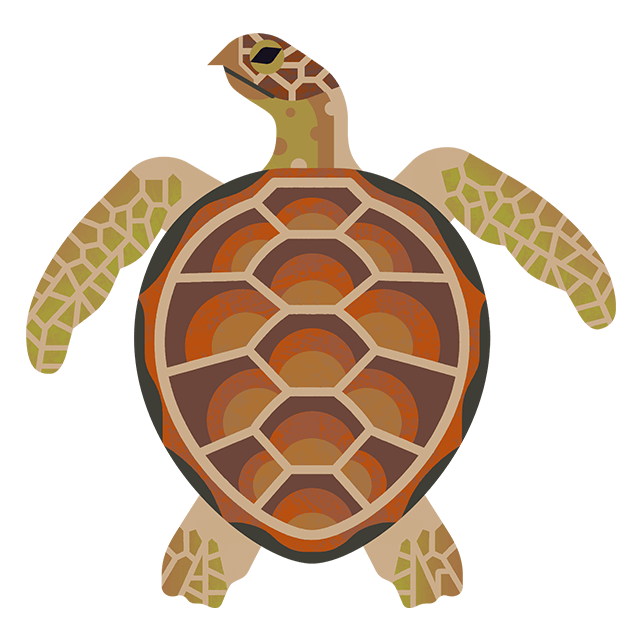
The true value of marine turtles
3 minute read
Marine turtles are valuable creatures – in so many ways. For millions of years, they’ve been providing benefits to marine ecosystems, the wider environment, and us humans, too.
From keeping ocean habitats healthy and boosting local economies, to providing shelter, and transport for ocean creatures, turtles play an important role for us all.

Credit: Peter Richardson
Protecting coral reefs and seagrass beds
Hawksbill turtles play a vital role in coral reefs, which are increasingly threatened by climate change. Reefs rely on sea sponges to recover and recycle key nutrients released by corals, but if allowed to overgrow, sea sponges can suffocate corals, causing them to die. By eating sea sponges, hawksbills help prevent them from overgrowing, and protect precious coral reefs.
Because hawksbills eat several types of sea sponges, less-common species are able to grow, which increases the variety of life in the reefs and enhances the ocean’s biodiversity.
Green turtles mostly eat seagrasses and algae, grazing seagrass meadows like buffalo graze the plains. Grazing on seagrass helps keep them healthy and ensures that they can be productive. Seagrass beds provide habitats and food, and act as nurseries for several commercial fish species, offering them protection from predators. They also capture and store carbon, stabilise sediments and provide a home for a range of protected species like spiny and long snouted seahorses.
Once green turtles digest the seagrass, the turtle poo can be recycled and used by other marine organisms that live in seagrass beds.
Providing shelter, transport, and food
Marine turtles embark on extremely long journeys, migrating hundreds and even thousands of miles through the ocean. Many marine organisms join them on their travels, using turtles as a form of transport and protection. Barnacles, algae, crustaceans and other small creatures attach themselves to turtles, while fish swim underneath them, sheltering from predators. One loggerhead turtle has been found to have up to one hundred species of plants and animals living on it!
Turtles also act as a food source for many animals which prey on them – both in and out of the ocean. Crabs, birds, fish, and land mammals such as cats, dogs, and raccoons feed on hatchlings, while larger sea creatures like sharks, saltwater crocodiles, and orcas prey on adult turtles.

Credit: Peter Richardson
Boosting beaches and sea sediments
When female turtles lay their eggs and nests on beaches, they provide important nutrients for sand and vegetation. Unhatched eggs and empty eggshells act as a fertiliser for dune vegetation and beach grasses, encouraging growth which helps stabilise dunes and protect them from coastal erosion.
Loggerhead turtles feed on hard-shelled prey, crushing the shells with their strong jaws and discarding the fragments. This causes the shells to disintegrate more quickly, helping to recycle and distribute important nutrients to the ocean floor sediments.
Culture and tourism
Marine turtles hold spiritual or symbolic significance in various cultures around the world. Some indigenous cultures refer to the North and Central Americas as ‘Turtle Island’, believing that earth was covered in water until land was formed on a turtle’s back.
The beliefs and symbolism of marine turtles depend on the culture. They can symbolise long life and abundance, patience, wisdom, endurance, a connection to Mother Earth, a connection to the past, or may be seen as messengers from ancestors.
As well as playing an important cultural role, turtles generate ecotourism and income for coastal communities. Whether hatching from eggs, charging to the sea or swimming through reefs, people go to watch these charismatic creatures – providing an economic boost to the communities they visit.
And, of course some countries still eat turtles, with harvests ranging from the massive commercial harvests of 8,000 to 11,000 green turtles caught per year in Nicaragua, to the small subsistence fisheries of less than 10 turtles per year in Montserrat. As long as these fisheries are managed sustainably, they can provide important cultural benefits to the communities that use them, as well as support much-needed food security for generations to come in an uncertain world with a changing climate.
Sadly, these extraordinary creatures are threatened as a result of a range of human activities, from beach front development, plastic pollution and worst of all, climate change. We’re working to help protect them, and you can play your part, too, by reporting any turtles you encounter.


